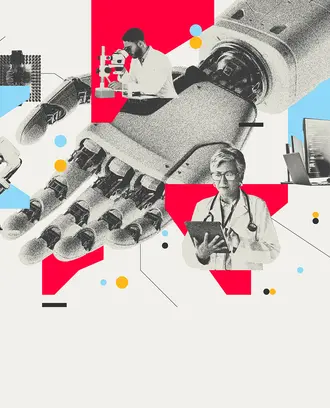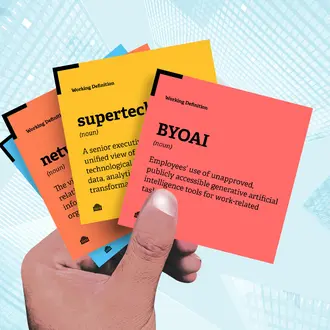From the audience, the trapeze tricks and high wire stunts at Cirque du Soleil look effortless as performers breeze through sophisticated routines.
Behind the scenes, the performers are constantly responding to each other and their surroundings, and have carefully coordinated all the elements, including sound and light. “If the wrong light cue happens, someone could die,” MIT Sloan lecturersaid. “What we see as this seamless, elegant experience has so much scaffolding happening in the background."
As the performers react to changes and work with each other in the moment, "that stability gives them the freedom to be the world’s most creative people,” Shapira said — and there is a lot to learn from them.
Lessons from the Cirque du Soleil performers, along with artists like sculptor Louise Nevelson, painter Frank Stella, dancer Twyla Tharp, and jazz icon Miles Davis, are at the core of the new MIT Sloan course “Leadership in Practice: Making and Learning,” led by Shapira and MIT Sloan professor Wanda Orlikowski. The course, offered for the first time last fall, blends theory and research about leadership and adult development with immersive experiences that put theory into practice. The course will be offered again in spring 2021, though whether in-person or online is yet to be determined.
“What we’re doing is transforming creative process into a cultural practice,” said Shapira, a professional painter, coach, and facilitator who has designed leadership courses for organizations including NASA, Google, and IBM with his company Tilt. “How do leaders enable a culture to have these capabilities?”
The course uses the “Four Capabilities Model,” a leadership framework created by Orlikowski and fellow MIT Sloan professors Deborah Ancona, Thomas Malone, and Peter Senge. The four capabilities outline the wide-ranging skills required for effective leadership:
- Sensemaking: understanding the context in which a company and its people operate.
- Relating: building relationships within and across organizations.
- Visioning: creating a compelling vision of the future.
- Inventing: innovating and developing new ways to achieve the vision.
Leaders can quickly grasp these skills cognitively, Shapira said, but what does “sensemaking” or “visioning” look like in action, and how can someone implement it? By watching how creative professionals work, students see nouns turn into verbs and learn how to model the capabilities for their employees.
The class isn’t about teaching students to paint or play the piano. “If we take the instruments away from musicians, we strip the brushes away from the painters … and we just look at the practices and the cultures through which they are working adaptively and creatively together, these interlocking skills that have been long-established in the arts can inform new leadership tools that are not actually new but drawn from a different domain,” he said.
Learn to improvise with jazz musicians
For the first class last fall, students arrived to find a full jazz group in the classroom. “At first the students approached it with healthy skepticism, ‘What am I going to learn about leadership from jazz, from a musician?’” Shapira said.“Let's just look at how they organize as a culture around each other as things are changing really fast, and what decisions they make with commitment in a world of moving targets,” Shapira said.
Aithan Shapira, MIT Sloan lecturer and professional painter.
Students observed how the individual musicians behave as a group, especially while improvising, and mapped the four capabilities to the jazz performance — like watching how a saxophone player responds to others, finds the common context the group is working in, and navigates toward a vision through improvisation, a key part of jazz. “How is she visioning?” Shapira asked. “And how is the group responding and sensemaking in that moment?”
Students learn on three levels: experientially, by seeing how professionals in arts disciplines react to each other and make decisions for themselves; intellectually, by learning frameworks and studying adult development models; and reflectively, responding to how these experiences and frameworks challenge them both professionally and personally.
Watching how the musicians are successful in the jazz setting invites leaders to establish similar practices for sensemaking, relating, inventing, and visioning, Shapira said.
Learn how to make sense of the world with artists
To understand sensemaking, the class takes an art tour of the MIT campus. People have different ways of responding to and interpreting art, Shapira said, and the class is invited to think about how that translates to drawing out diverse perspectives when considering data and business decisions.
“Art is basically data. It's raw visual information,” Shapira said. “How are we going to make sense around this, and what are tools and practices we can employ from the creative world?”
Students are invited to switch from the creative world to organizational development to embody the dynamics of sensemaking as they try to interpret and negotiate data to solve business problems. Instead of hastily naming or solving a problem, they are encouraged to explore how to make sense of the situation, collectively.
The artwork students study — like a stone sculpture by Cai Guo-Qiang on the MIT Sloan campus, which features 12 links carved out of granite with Japanese black pine trees planted inside the links — comes to serve as a visual cue in their daily lives, Shapira said. Instead of sensemaking as an abstract idea, students have a visual reminder about the practice every time they walk by the sculpture on their way to class. This reinforces the idea, Shapira said, and helps students form a relationship to the school.
Learn how to embrace change from Picasso
As a young painter, Pablo Picasso worked with somber blue paints during his Blue Period, later transitioning to a lighter tone and colorful shades of pink and orange for his Rose Period. Later he turned to Cubism, Surrealism, and sculpture.
What can leaders learn from this? “Permission to change,” Shapira said. “You get recognized for one thing, everyone knows you as being that thing, and shifting, at times even radically, has to do with your commitment to actively visioning in context with the changing world.
”Picasso’s disciplined practice with change worked across his lifetime and within moments of painting," Shapira said. The painter once said, “I begin with an idea, and then it becomes something else.” This is another way to describe visioning, Shapira said — innovating toward the future, even a radically different one, and finding how one painting, or an entire career, will evolve toward that goal.
“There's a lot of risk that goes into that, professionally and personally,” he said.
Leadership, like painting and other pursuits, requires becoming an evolving, self-reflective learner. This is one of the takeaways from the class, Shapira said. Nobody ever achieves 100% in visioning or relating, but you can get better at using those skills. “It's not a destination, but a direction,” he said.



